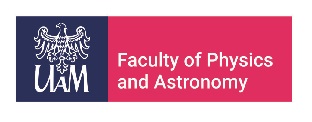
M.Sc. Vrishali Sonar
Department of Mesoscopic Physics
- Loc: wing J, 2nd floor, room 216
- Email: vrison@amu.edu.pl
Scientific degrees
M.Sc. In Physics- 2018 at Pune University, India
Research interests
Thermoelectric transport, spintronics, Bethe ansatz, strongly correlated systems, ab initio lattice dynamics.
Publications
2025 |
|
| 4. | Vrishali Sonar, Piotr Trocha Scientific Reports, 15 (1), pp. 14509, 2025, ISSN: 2045-2322. @article{sonar_spin_2025, title = {Spin dependent thermoelectric transport in a multiterminal quantum dot hybrid including a superconductor and ferromagnets}, author = {Vrishali Sonar and Piotr Trocha}, url = {https://www.nature.com/articles/s41598-025-94991-2}, doi = {10.1038/s41598-025-94991-2}, issn = {2045-2322}, year = {2025}, date = {2025-04-25}, urldate = {2025-05-30}, journal = {Scientific Reports}, volume = {15}, number = {1}, pages = {14509}, abstract = {We investigate the thermoelectric response of a hybrid system consisting of two ferromagnetic electrodes and one superconducting lead coupled to a single-level quantum dot with finite Coulomb repulsion. Using the non-equilibrium Green’s function technique within the Hubbard-I approximation, local and non-local thermoelectric coefficients, along with their spin counterparts, such as electrical and thermal conductance, and the Seebeck coefficient are calculated up to linear order with respect to generalized forces. Here, we present a derivation of spin-dependent thermoelectric coefficients for a three-terminal system, extending the existing theory which allowed to describe only cases independent of spin-bias voltage, i.e. when spin accumulation is irrelevant. In the considered system, four competing processes- single particle tunneling, quasiparticle tunneling, direct and crossed Andreev reflection make the system highly adaptable for tuning charge and heat currents. A full analysis of their impact on thermoelectric effects is provided. Moreover, the output power and efficiency of the system operating as a heat engine are evaluated. The extensive goal of this work is to demonstrate how the presence of an additional terminal modifies the hybrid QD-based device’s performance and under which conditions non-local thermoelectric effects become significant.}, keywords = {}, pubstate = {published}, tppubtype = {article} } We investigate the thermoelectric response of a hybrid system consisting of two ferromagnetic electrodes and one superconducting lead coupled to a single-level quantum dot with finite Coulomb repulsion. Using the non-equilibrium Green’s function technique within the Hubbard-I approximation, local and non-local thermoelectric coefficients, along with their spin counterparts, such as electrical and thermal conductance, and the Seebeck coefficient are calculated up to linear order with respect to generalized forces. Here, we present a derivation of spin-dependent thermoelectric coefficients for a three-terminal system, extending the existing theory which allowed to describe only cases independent of spin-bias voltage, i.e. when spin accumulation is irrelevant. In the considered system, four competing processes- single particle tunneling, quasiparticle tunneling, direct and crossed Andreev reflection make the system highly adaptable for tuning charge and heat currents. A full analysis of their impact on thermoelectric effects is provided. Moreover, the output power and efficiency of the system operating as a heat engine are evaluated. The extensive goal of this work is to demonstrate how the presence of an additional terminal modifies the hybrid QD-based device’s performance and under which conditions non-local thermoelectric effects become significant. |
| 3. | Vrishali Sonar, Piotr Trocha Sci. Rep., 15 , pp. 14509, 2025. @article{Sonar2025, title = {Spin dependent thermoelectric transport in a multiterminal quantum dot hybrid including a superconductor and ferromagnets}, author = {Vrishali Sonar and Piotr Trocha}, url = {https://www.nature.com/articles/s41598-025-94991-2}, doi = {10.1038/s41598-025-94991-2}, year = {2025}, date = {2025-04-25}, journal = {Sci. Rep.}, volume = {15}, pages = {14509}, abstract = {We investigate the thermoelectric response of a hybrid system consisting of two ferromagnetic electrodes and one superconducting lead coupled to a single-level quantum dot with finite Coulomb repulsion. Using the non-equilibrium Green’s function technique within the Hubbard-I approximation, local and non-local thermoelectric coefficients, along with their spin counterparts, such as electrical and thermal conductance, and the Seebeck coefficient are calculated up to linear order with respect to generalized forces. Here, we present a derivation of spin-dependent thermoelectric coefficients for a three-terminal system, extending the existing theory which allowed to describe only cases independent of spin-bias voltage, i.e. when spin accumulation is irrelevant. In the considered system, four competing processes- single particle tunneling, quasiparticle tunneling, direct and crossed Andreev reflection make the system highly adaptable for tuning charge and heat currents. A full analysis of their impact on thermoelectric effects is provided. Moreover, the output power and efficiency of the system operating as a heat engine are evaluated. The extensive goal of this work is to demonstrate how the presence of an additional terminal modifies the hybrid QD-based device’s performance and under which conditions non-local thermoelectric effects become significant.}, keywords = {}, pubstate = {published}, tppubtype = {article} } We investigate the thermoelectric response of a hybrid system consisting of two ferromagnetic electrodes and one superconducting lead coupled to a single-level quantum dot with finite Coulomb repulsion. Using the non-equilibrium Green’s function technique within the Hubbard-I approximation, local and non-local thermoelectric coefficients, along with their spin counterparts, such as electrical and thermal conductance, and the Seebeck coefficient are calculated up to linear order with respect to generalized forces. Here, we present a derivation of spin-dependent thermoelectric coefficients for a three-terminal system, extending the existing theory which allowed to describe only cases independent of spin-bias voltage, i.e. when spin accumulation is irrelevant. In the considered system, four competing processes- single particle tunneling, quasiparticle tunneling, direct and crossed Andreev reflection make the system highly adaptable for tuning charge and heat currents. A full analysis of their impact on thermoelectric effects is provided. Moreover, the output power and efficiency of the system operating as a heat engine are evaluated. The extensive goal of this work is to demonstrate how the presence of an additional terminal modifies the hybrid QD-based device’s performance and under which conditions non-local thermoelectric effects become significant. |
2024 |
|
| 2. | Vrishali Sonar, Piotr Trocha Non-local thermoelectric transport in multi-terminal quantum dot hybrid system Journal of Magnetism and Magnetic Materials, 593 , pp. 171745, 2024. @article{Sonar2024, title = {Non-local thermoelectric transport in multi-terminal quantum dot hybrid system}, author = {Vrishali Sonar and Piotr Trocha}, url = {https://www.sciencedirect.com/science/article/pii/S0304885324000350?via%3Dihub}, doi = {10.1016/j.jmmm.2024.171745}, year = {2024}, date = {2024-03-01}, journal = {Journal of Magnetism and Magnetic Materials}, volume = {593}, pages = {171745}, abstract = {The heat and charge transport is studied in a hybrid multi-terminal device consisting of one metallic, one ferromagnetic and a superconducting lead coupled to quantum dot. The basic thermoelectric properties of the system are examined using non-equilibrium Green’s function method with finite on-dot Coulomb repulsion within Hubbard-I approximation. Local and non-local transport coefficients including electrical and thermal conductance, Seebeck coefficient calculated in the linear response regime. Main objective is to analyze effect of superconductor coupling and ferromagnet’s spin polarization on thermoelectric transport and how ferromagnetic lead modifies it. We also studied the role of different electron tunneling types, i. e. Andreev reflection, quasi-particle and normal single particle tunneling processes on thermoelectric properties of the considered system.}, keywords = {}, pubstate = {published}, tppubtype = {article} } The heat and charge transport is studied in a hybrid multi-terminal device consisting of one metallic, one ferromagnetic and a superconducting lead coupled to quantum dot. The basic thermoelectric properties of the system are examined using non-equilibrium Green’s function method with finite on-dot Coulomb repulsion within Hubbard-I approximation. Local and non-local transport coefficients including electrical and thermal conductance, Seebeck coefficient calculated in the linear response regime. Main objective is to analyze effect of superconductor coupling and ferromagnet’s spin polarization on thermoelectric transport and how ferromagnetic lead modifies it. We also studied the role of different electron tunneling types, i. e. Andreev reflection, quasi-particle and normal single particle tunneling processes on thermoelectric properties of the considered system. |
2022 |
|
| 1. | Vrishali Sonar, Rohan Dehankar, K. P. Vijayalakshmi, Natalio Mingo, Ankita Katre Site-independent strong phonon-vacancy scattering in high-temperature ceramics ZrB2 and HfB2 Phys. Rev. Materials, 6 , pp. 065403, 2022. @article{Sonar2022, title = {Site-independent strong phonon-vacancy scattering in high-temperature ceramics ZrB2 and HfB2}, author = {Vrishali Sonar and Rohan Dehankar and K. P. Vijayalakshmi and Natalio Mingo and Ankita Katre}, url = {https://journals.aps.org/prmaterials/abstract/10.1103/PhysRevMaterials.6.065403}, doi = {10.1103/PhysRevMaterials.6.065403}, year = {2022}, date = {2022-06-10}, journal = {Phys. Rev. Materials}, volume = {6}, pages = {065403}, abstract = {Similar effects of metal and boron vacancies on phonon scattering and lattice thermal conductivity (κl) of ZrB2 and HfB2 are reported. These defects challenge the conventional understanding that associates larger impacts to bigger defects. We find the underlying reason to be a strong local perturbation caused by boron vacancy that substantially changes the interatomic force constants. In contrast, a long ranged but weaker perturbation is seen in the case of metal vacancy. We show that these behaviors originate from a mixed metallic and covalent bonding nature in the metal diborides. The thermal transport calculations are performed in a complete ab initio framework based on Boltzmann transport equation and density functional theory. Phonon-vacancy scattering is calculated using ab initio Green's function approach. Effects of natural isotopes and grain boundaries on κl are also systematically investigated, however we find an influential role of vacancies to explain large variations seen in the experiments. We further report a two-order of magnitude difference between the amorphous and pure-crystal limits. Our results outline significant material design aspects for these multifunctional high-temperature ceramics.}, keywords = {}, pubstate = {published}, tppubtype = {article} } Similar effects of metal and boron vacancies on phonon scattering and lattice thermal conductivity (κl) of ZrB2 and HfB2 are reported. These defects challenge the conventional understanding that associates larger impacts to bigger defects. We find the underlying reason to be a strong local perturbation caused by boron vacancy that substantially changes the interatomic force constants. In contrast, a long ranged but weaker perturbation is seen in the case of metal vacancy. We show that these behaviors originate from a mixed metallic and covalent bonding nature in the metal diborides. The thermal transport calculations are performed in a complete ab initio framework based on Boltzmann transport equation and density functional theory. Phonon-vacancy scattering is calculated using ab initio Green's function approach. Effects of natural isotopes and grain boundaries on κl are also systematically investigated, however we find an influential role of vacancies to explain large variations seen in the experiments. We further report a two-order of magnitude difference between the amorphous and pure-crystal limits. Our results outline significant material design aspects for these multifunctional high-temperature ceramics. |


